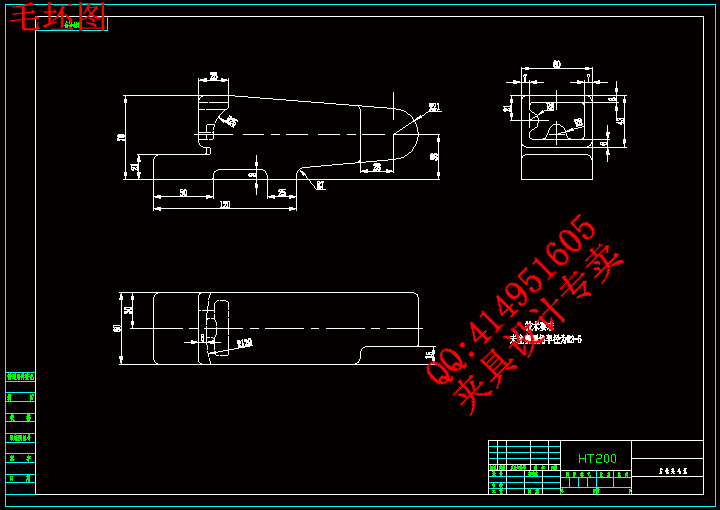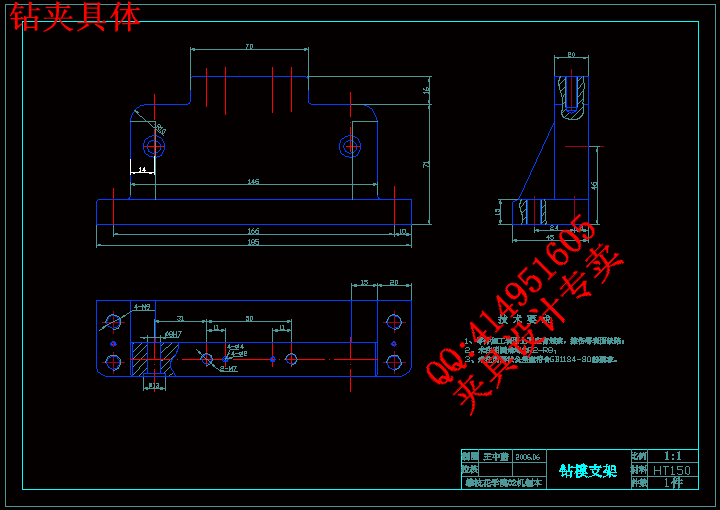【温馨提示】 购买原稿文件请充值后自助下载。
[全部文件] 那张截图中的文件为本资料所有内容,下载后即可获得。
预览截图请勿抄袭,原稿文件 清晰完整,无水印,可编辑。
有疑问可以咨询QQ:414951605或1304139763
摘 要
在生产过程中,使生产对象(原材料,毛坯,零件或总成等)的质和量的状态发生直接变化的过程叫工艺过程,如毛坯制造,机械加工,热处理,装配等都称之为工艺过程。在制定工艺过程中,要确定各工序的安装工位和该工序需要的工步,加工该工序的机车及机床的进给量,切削深度,主轴转速和切削速度,该工序的夹具,刀具及量具,还有走刀次数和走刀长度,最后计算该工序的基本时间,辅助时间和工作地服务时间。
关键词 工序,工艺,工步,加工余量,定位方案,夹紧力
ABSTRACT
Enable producing the target in process of production (raw materials, the blank , state of quality and quantity on part become always ) take place direct course of change ask craft course, if the blank is made, machining, heat treatment , assemble etc. and call it the craft course. In the course of making the craft , is it confirm every erector location and worker step that process need this of process to want, the locomotive of processing , this process , and the entering the giving amount of the lathe, cut depth , the rotational speed of the main shaft and speed of cutting, the jig of this process, the cutter and measuring tool, a one hundred sheets of number of times still leaves and a one hundred sheets of length leaves, calculate basic time of this process , auxiliary time and service time of place of working finally.
Keywords: The process, worker one, worker's step , the surplus of processing, orient the scheme , clamp strength
目 录
摘 要I
ABSTRACTII
1 CA6140机床后托架加工工艺3
1.1 CA6140机床后托架的工艺分析3
1.2 CA6140机床后托架的工艺要求及工艺分析3
1.2.1 CA6140机床`后托架的技术要求4
1.3 加工工艺过程4
1.4 确定各表面加工方案4
1.4.1 在选择各表面及孔的加工方法时,要综合考虑以下因素5
1.4.2 平面的加工5
1.4.3孔的加工方案5
1.5 确定定位基准6
1.5.1 粗基准的选择6
1.5.2 精基准选择的原则7
1.6 工艺路线的拟订7
1.6.1工序的合理组合7
1.6.2 工序的集中与分散8
1.6.3 加工阶段的划分9
1.6.4 加工工艺路线方案的比较10
1.7 CA6140机床后托架的偏差,加工余量,工序尺寸及毛坯尺寸的确定13
1.7.1 毛坯的结构工艺要求13
1.7.2 CA6140机床后托架的偏差计算13
1.8 确定切削用量及基本工时(机动时间)17
1.8.1 工序1:粗、精铣底面17
1.8.2 工序2 粗、半精、精镗CA6140侧面三杠孔18
1.8.3 工序3:钻顶面四孔25
1.8.4 工序4:钻侧面两孔29
1.9 时间定额计算及生产安排31
1.9.1 粗、精铣底面31
1.9.2 镗侧面三杠孔32
1.9.3 钻顶面四孔33
2 专用夹具设计35
2.1 铣平面夹具设计35
2.1.1 研究原始质料35
2.1.2 定位基准的选择35
2.1.3 切削力及夹紧分析计算35
2.1.4 误差分析与计算36
2.1.5 夹具设计及操作的简要说明37
2.2 镗孔夹具设计37
2.2.1 研究原始质料37
2.2.2 定位基准的选择37
2.2.3 切削力及夹紧力的计算38
2.2.4 误差分析与计算40
2.3钻顶面四孔夹具设计40
2.3.1 研究原始质料40
2.3.2 定位基准的选择41
2.3.3 切削力及夹紧力的计算41
2.3.4 误差分析与计算42
2.3.5 夹具设计及操作的简要说明42
结 论43
参考文献44
致 谢45
机床后托架加工工艺
1.1 CA6140机床后托架的工艺分析
CA6140机床后托架的是CA6140机床的一个重要零件,因为其零件尺寸较小,结构形状也不是很复杂,但侧面三杠孔和底面的精度要求较高,此外还有顶面的四孔要求加工,但是对精度要求不是很高。后托架上的底面和侧面三杠孔的粗糙度要求都是,所以都要求精加工。其三杠孔的中心线和底平面有平面度的公差要求等。因为其尺寸精度、几何形状精度和相互位置精度,以及各表面的表面质量均影响机器或部件的装配质量,进而影响其性能与工作寿命,因此它的加工是非常关键和重要的。
1.2 CA6140机床后托架的工艺要求及工艺分析
图1.1 CA6140机床后托架零件图
一个好的结构不但要应该达到设计要求,而且要有好的机械加工工艺性,也就是要有加工的可能性,要便于加工,要能够保证加工质量,同时使加工的劳动量最小。而设计和工艺是密切相关的,又是相辅相成的。设计者要考虑加工工艺问题。工艺师要考虑如何从工艺上保证设计的要求。
1.2.1 CA6140机床后托架的技术要求
其加工有三组加工。底面、侧面三孔、顶面的四个孔、以及左视图上的两个孔。
⑴.以底面为主要加工的表面,有底面的铣加工,其底面的粗糙度要求是,平面度公差要求是0.03。
⑵.另一组加工是侧面的三孔,分别为,,,其表面粗糙度要求 要求的精度等级分别是,,。
⑶.以顶面为住加工面的四个孔,分别是以和为一组的阶梯空,这组孔的表面粗糙度要求是,,以及以和的阶梯孔,其中是装配铰孔,其中孔的表面粗糙度要求是,,是装配铰孔的表面粗糙度的要求是。
⑷.CA6140机床后托架毛坯的选择金属行浇铸,因为生产率很高,所以可以免去每次造型。
单边余量一般在,结构细密,能承受较大的压力,占用生产的面积较小。因为CA6140机床后托架的重量只有3.05kg,而年产量是5000件,由[7]《机械加工工艺手册》表2.1-3可知是中批量生产。
1.3 加工工艺过程
由以上分析可知。该箱体零件的主要加工表面是平面及孔系。一般来说,保证平面的加工精度要比保证孔系的加工精度容易。因此,对于CA6140机床后托架来说,加工过程中的主要问题是保证孔的尺寸精度及位置精度,处理好孔和平面之间的相互关系。
由上面的一些技术条件分析得知:CA6140后托架的尺寸精度,形状机关度以及位置机精度要求都很高,就给加工带来了困难,必须重视。
1.4 确定各表面加工方案
一个好的结构不但应该达到设计要求,而且要有好的机械加工工艺性,也就是要有加工的可能性,要便于加工,要能保证加工的质量,同时是加工的劳动量最小。设计和工艺是密切相关的,又是相辅相成的。对于我们设计CA6140机床后托架的加工工艺来说,应选择能够满足孔系加工精度要求的加工方法及设备。除了从加工精度和加工效率两方面考虑以外,也要适当考虑经济因素。在满足精度要求及生产率的条件下,应选择价格较底的机床。
1.4.1 在选择各表面及孔的加工方法时,要综合考虑以下因素
⑴.要考虑加工表面的精度和表面质量要求,根据各加工表面的技术要求,选择加工方法及分几次加工。






 川公网安备: 51019002004831号
川公网安备: 51019002004831号